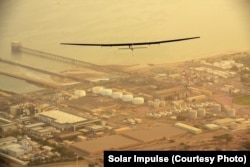A solar-powered Swiss airplane took off early Sunday for a six-day flight over the Pacific Ocean, in the most difficult leg of its journey around the globe.
The Solar Impulse 2 took off from Nanjing in eastern China, heading for the U.S. island state of Hawaii 8,500 kilometers (5,280 miles) away, after extended delays awaiting a suitable weather window because of safety concerns.
The is the sixth leg of the plane's around-the-world, 35,000-kilometer (21,700-mile) journey.
The carbon fiber, single-seat Solar Impulse 2 has a 72-meter (236-foot) wingspan, which is longer than the wingspan of a Boeing 747, and weighs about as much as a car. The 17,000 solar cells built into the wings harness the sun's energy, allowing it to fly through the night.
The Si2 took 12 years to build and is the brainchild of two Swiss scientists, Bertrand Piccard and Andre Borschberg.
The two say they are not out to revolutionize the aviation industry, but are instead aiming to demonstrate that actual alternative energy sources and new technologies can achieve what some consider impossible.
The aircraft's route includes stops in Oman, India, Myanmar and China. After crossing the Pacific Ocean via Hawaii, the plane will make up to three stops in the U.S., touching down in Phoenix, New York City and possibly another location depending on weather conditions.
The final legs after crossing the Atlantic include a stop in southern Europe or North Africa before arriving back in Abu Dhabi in late July or early August.










